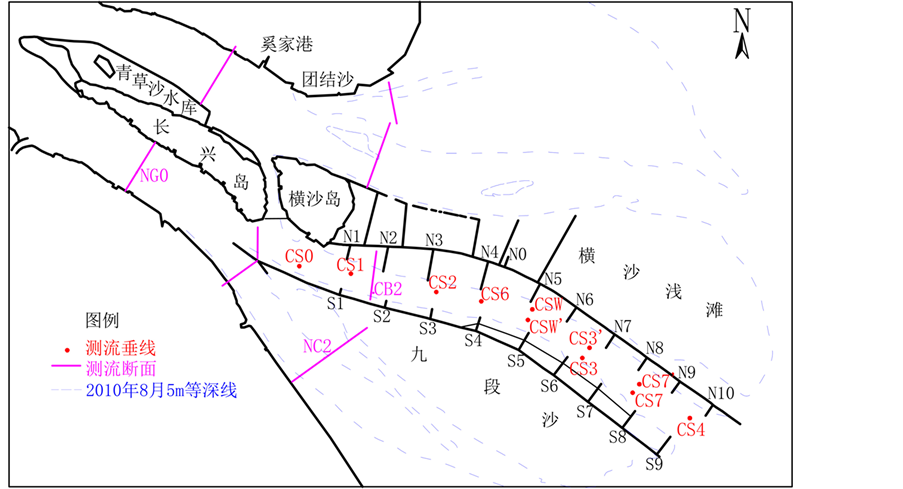1. 概述
1.1. 长江口河道特征
长江河口段平面形态呈喇叭型,为三级分汊、四口入海的河势格局。进口徐六泾江面宽4.5 km,口门启东嘴至南汇嘴展宽至90 km。徐六泾以下,崇明岛将长江分成南支和北支;南支在吴淞口附近由长兴岛和横沙岛将河道分为南港和北港;南港在横沙岛尾附近由九段沙分为南槽和北槽两个汊道,从而形成北支、北港、北槽、南槽四个入海通道 [1] ,长江口现状河势图如图1所示。
1.2. 长江口水文气象特征
长江口水域广阔,是一个陆海双向来沙,径、潮流共同作用的潮汐河口,水流动力因素复杂。径流量及潮流量均很大,潮汐作用较强,同时季节性风浪的作用也较为强烈,水体含沙量及盐度的时空分布也十分复杂。
长江口地区属亚热带季风气候,气候温和,四季分明,雨水丰沛,日照充足。受地理位置和季风影响,气候具有海洋性和季风性双重特征。
1.3. 长江口深水航道治理工程简介
按照国务院关于长江口深水航道治理工程“一次规划,分期建设,分期见效”的要求,长江口深水航道治理工程分三期实施。一期工程航道实现8.5 m水深,航道底宽300 m;二期工程航道水深增深至10.0 m,航道底宽350~400 m;三期工程进一步增深至12.5 m,航道底宽350~400 m。一、二、三期工程平面布置图见图2。
长江口深水航道治理工程于1998年1月27日开工,经历了13年的建设全长92.2 km、宽350~400 m、水深12.5 m的长江口深水航道建成,全部工程于2011年5月18日通过国家验收并正式投入使用。
2. 长江口航道治理工程对水文资料的需求及测验布置
随着长江口深水航道建设工程和周边大型涉水工程的建设,势必引起水流边界条件发生变化,使得工程区域水沙条件变化更复杂,限于学科的发展水平,在前期研究及工程建设阶段难以透彻研究可能存在的各类问题,因此需要通过收集工程建设时期的连续的水流、泥沙等基础资料,应用数模、物模来进行分析、验证对工程实

Figure 1. Current river regime of the Changjiang estuary
图1. 长江口现状河势图

Figure 2. Plane graph of the first, second and third stage of the Deepwater Navigational Channel Regulation Project in the Changjiang estuary
图2. 长江口深水航道治理一、二、三期工程平面布置图
施的影响。长江口水文监测垂线及断面布置位置坐标见表1、表2,平面布置图见图3。
3. 水文监测技术应用
长江口深水航道治理工程位于长江口潮流界内,受潮汐、径流、风浪等多因素影响,水流流态、水流结构
时空分布复杂,整个工程作业面大,远离陆地的工区占2/3,给水文监测测船导航、定位、ADCP测流及流速流向测验提出了新的要求。
3.1. 测船的导航定位
由于工程建设区域由近岸向长江口入海口距离不断增大,因此水文测船导航定位的技术也是很重要的一个因素,为了保证水文测船能精确到达计划位置,定位技术先后采用了MOTOLA GPS定位技术,2000年沿海及长江口区域建设了GPS差分基站,此后采用了GPS信标定位技术,使得测船定位精度有了较大提高 [2] 。定位仪的型号及技术指标见表3。
由于GPS信标导航定位技术的应用,实现了整个监测区域的每条测船都能有一台GPS信标机用于测船导航

Table 1. Coordinate of ADCP gauging section (central meridian: 123˚)
表1. ADCP测验断面位置坐标(中央子午线123度)

Table 2. Coordinate of fixed vertical lines (central meridian: 123˚)
表2. 固定垂线位置坐标(中央子午线123度)

Table 3. Successively used locators and corresponding main technical specifications
表3. 先后使用的定位仪及主要技术指标
和定位,每次测验测区都能有两台备用GPS信标机,从而满足了整个测验对定位仪器的需求。每年对每台DGPS信标机送到省级测绘质检部门进行检查和率定;新购买的GPS信标机使用前均通过连续采集10 min平面位置坐标与已知坐标点(一般使用国家三等平面控制点)进行比较,当两者误差在亚米级时就可以投入使用,从而保证了定位精度。
3.2. 固定垂线的水流、泥沙测验
在深水航道治理工程中,采用固定垂线方法施测典型位置大潮、中潮、小潮三个代表潮的全潮的流速、流

Figure 3. Layout of hydrological gauging in the Changjiang estuary
图3. 长江口水文监测布置图
向、含沙量、悬移质和底质颗分资料,为数模和物模提供率定及验证资料。
3.2.1. 流速、流向测验
由于工程区域风浪大,过往大型船舶航行形成的波浪大,流速流向测验使用的仪器先后采用了LS25型流速仪和ZSX-3型流向仪;在工程实施过程中为了验证水工构筑物的实施对水流流速和流向调整效果,需要精确测定流速、流向,水文监测部门与国内仪器研制生产单位联合开发应用了ZSX-4型数字式流速流向仪。ZSX-4型流速、流向仪,流向精度达到0.5˚,同时该仪器实现了对采集数据的自记,从而大大减轻了劳动强度,提高了工作效率。
为了满足研究单位对水温沿水深的分布资料的需求,水文监测部门2009年8月起,通过与仪器研制单位共同制定流速、流向和水温的技术指标和采集数据的自记数据格式,并组织仪器的研制,实现了流速、流向、水温同步施测和自记,取得了测验期间完整的水温沿水深分布的资料,为研究泥沙絮凝、沉降和运动提供了基础资料。
使用的各型号的测流仪器均按照《河流流量测验规范》的要求与标准仪器进行比测或送水文仪器监测单位进行率定,具体的率定和比测频次可根据流速仪的性能、使用历时的长短及使用期间流速和含沙量的大小等情况而定。比测在水流平稳的时期和流速脉动较小、流向一致的地点进行;每次比测包括大、中、小流速且分布均匀的30个以上的测点,当比测结果偏差不超过3%,比测条件差的不超过5%,且系统误差能控制在±1%范围内时,流速仪可以继续使用,超过上述偏差就停止使用,并查明原因,分析其对已测资料的影响,随后送水文仪器检验单位进行维修和率定 [3] 。
3.2.2. 悬沙取样
悬沙采样采用横式采样器,采样容积和装样容积均为1000 ml,悬沙采样每个小时采样一次,每次按六点法取样,1998年~2002年在悬沙取样期间,因测验水域含盐度高造成铁质采样器锈蚀现象,每个全潮测验完毕,采样器的主体结构锈蚀严重,为了解决这个问题监测单位与采样器生产厂家共同对横式采样器的材料进行了分析研究,2003年采用不锈钢材质的采样器,从而提高了采样器的使用时间和采样效率 [4] 。
为了降低潮汐河段因水流涨落变化对含沙量分层取样的影响,在悬沙六点法取样时,为缩短采样时间,监测单位将取样绞车从手摇方式改为电动方式,大大缩短了取样历时,提高了泥沙的采样效率和资料的利用效果。
3.2.3. 悬沙称重实现自动化
含沙量分析采用焙干法,限于当时的技术条件,沙样称重都采用1/10,000机械天平人工称重,由于长江口航道建设工程泥沙监测周期长、监测范围大,通常多船组全潮测验每次采集的水样近10,000余点,常规称重方法难以满足设计、施工、科研对泥沙资料时间进度的要求,同时人工称重计算极易引起计算差错,需要进行一称双校的工序,手工称重流程大大影响提供含沙量资料的进度,为了缩短含沙量分析时间,水文监测单位将机械天平称重更新为电子天平称重,同时采用数据库技术开发了电子天平与计算机连接的自动称重分析系统,实现了从称重到含沙量数据合理性检查分析、数据入库全过程自动化,人工只需将烘好的烧杯放入电子天平中即可,大大缩短了分析时间,提高了资料的精度,减轻了劳动强度。
3.2.4. 底质取样
底质采样器先后使用过拖斗式底质采样器、抓斗式采样器。拖斗式采样器制作简单易操作,但在使用过程中易发生水流梳洗,仅在1998年~2000年期间使用,后改为抓斗式采样器进行底质取样。
3.2.5. 颗分粒径分析
悬沙和底质颗粒级配分析采用移液管与消光仪结合法,这两种方法分析时间长,2001年开始使用马尔文激光粒度分析仪。该仪器的特点是分析范围大,对工程区域的细颗粒泥沙具有很好的适应性 [5] 。
3.3. ADCP的应用
常规的固定垂线虽然能收集到典型位置、代表潮的水流、泥沙资料,但与设计、施工、科研等对水文资料的大范围全过程需求相比仍难以满足要求;水文监测部门将ADCP开发性的应用于工程区域内主要汊道的分流分沙比和流场监测 [6] 。
3.3.1. ADCP在分流比分沙比监测应用
长江口三级分汊四口入海,各汊道的分流分沙比的大小及变化是评价汊道发育程度和发展的一个重要指标。应充分掌握河口自然演变及河口涉水工程实施对各汊道分流分沙的影响。在ADCP未引进之前分流沙比的测验采用一船多线法、多船多线法,用流速流向仪施测固定垂线全潮逐时流速流向过程,根据潮位和大断面资料推求逐时断面流量和输沙率,进而计算一个潮周期的潮量和沙量。对于长江口南北港、南北槽这样大型船通航密度大、风浪大、江面宽的断面,采用多船多线法,从安全、技术、经济等方面均难以满足要求,而ADCP动船流量测验则能较好地克服这些缺点,因此在长江口深水航道治理工程中,从1998年施工开始每年洪、枯季均利用ADCP动船测流和垂线取沙相结合的方法施测分流分沙比,南北港和南北槽分流分沙比逐年变化过程见图4和图5。
在ADCP动船测验中,利用ADCP和GPS联合应用技术,安排专业测船和专职驾驶人员,确保ADCP能沿断面线±1m的偏航距航行。根据断面通航环境及测区的风浪大小选择合理代表潮测验时机,取得了较好的水流、泥沙资料。
为了克服ADCP在高含沙量和河床易冲刷(动底)等水文环境对流速、流量测验精度的影响,监测部门先后采用高精度的GPS施测船速,提高测验精度;2010年起用GPS罗经测量测船航行方向,消除铁船体磁场对ADCP内罗经的影响,从而消除其影响,提高了潮流量测验精度。
每次测验前对断面几何形状、水流沿断面特性进行分析研究,为合理配置和优化测验参数提供依据,校对ADCP和GPS的时间,保证时间的一致性,提高流速、流量的测验精度。

Figure 4. Changing process of flow and sediment split ratio in the south-north channel
图4. 南北港分流分沙比变化过程图

Figure 5. Changing process of flow and sediment split ratio in the south-north passage
图5. 南北槽分流分沙比变化过程图
3.3.2. ADCP在流场测验中的应用
在工程护底排铺设前,为了了解拟铺排位置流速流向及流场分布,为安全施工提供基础资料,采用ADCP沿断面中轴线及护底排边缘线进行流场监测,测验过程中根据设计单位提供位置坐标布置测验航行线,根据水深和底质组成合理设置和优化测验参数。
在北槽导提建设的不同施工阶段,为验证工程实施后对工程影响段的流速、流向产生调整效果,在北槽的上、中、下段布设ADCP监测断面进行全潮断面流场监测验证工程措施的对水流流态的调整,为合理安排工程进度和强度提供流场资料。
3.3.3. ADCP数据处理软件的开发和应用
由于每次进行水文测验的规模大,涉及到ADCP测验断面十三个断面和22条垂线,每个全潮要施测30个测次(历时30个小时),为了整理ADCP水文测验收集到的大量资料,水文监测部门开发了ADCP数据处理软件,实现了ADCP监测数据自动采集及数据处理分析的自动化,提高了资料处理效率,缩短了资料处理的时间,增加了资料的时效性。
4. 越堤流监测
由于南导堤高程为吴淞基面(以下同)以上2.00 m,在大、中潮期当潮位高于2.00 m时,存在越堤流,即涨潮时涨潮流由南槽越堤进入北槽,落潮时落潮流由北槽进入南槽,为了研究北槽的航道泥沙的回淤机理,需要研究南槽与北槽通过南导堤涨落潮水沙交换过程及量值。
南导堤近九段沙附近的导堤,涨潮时受涨潮流的作用,易形成高含沙量水流,大潮时尤甚,高含沙量水流涨潮时进入北槽的水量及沙量的大小、落潮时是否会回流进入南槽,即南槽涨潮越堤的沙量对北槽回淤沙量的量值大小、输沙的部位等是建设单位、施工单位和管理单位关注的重点,为此水文监测单位2007年7月首次在大潮期采用潮位计、OBS、小阔龙联合监测方式,在南导堤N2-N3、N5-N6、N7-N8位置施测了越堤流的流速、流向和含沙量。具体是用OBS采集越堤水体浊度,采用横式采样器率定OBS含沙量,用水位计收集潮位过程,小阔龙收集距堤高0.3 m的越堤流流速、流向。进而推求越堤水量和沙量。2010年水文监测部门用小阔龙施测越堤流测沿垂线的流速流向分布,取得了更佳的效果,从而得出了南槽涨潮越堤流携带大量泥沙进入北槽、并在南导堤坝田区域落淤,而落潮时并未回灌南槽,后经进一步监测分析,进入坝田的泥沙在风浪的作用下部分进入北槽航道,从而引起北槽航道回淤量增加。
5. 结语
长江口深水航道治理工程是一项宏伟的工程,工程建设、维护、动态管理需要高质量的水文资料作为基础,水文监测部门采用传统水文仪器与现代水文仪器相结合的成熟、先进的监测技术,结合工作实际开发了ADCP数据处理和含沙量自动称重分析软件,改进了测流仪、横式采样器、电动绞车,提高了工作效率,提供和积累了大量水文资料。这些水文资料为长江口深水航道治理工程一期、二期和三期工程实施过程中解决一批重大技术问题提供了科学依据。